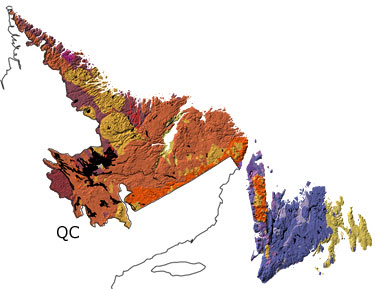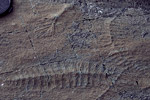Newfoundland and Labrador, Canada
|
|
|||||||||||||||||||||||||||||||||||||||||||||||||||||||||||||
Paleontology and geology
The Precambrian: Precambrian rocks in Newfoundland and Labrador include some of the oldest rocks on Earth, dating back to 3.8 billion years ago (Ga). The Precambrian sedimentary, igneous, and metamorphic rocks of this province make up the eastern part of the Canadian Shield. Laurentia (North America) was surrounded by shallow seas of the Iapetus Ocean, covering part of the Island of Newfoundland. Other parts of Newfoundland were located off the coast of Gondwana at this time, and they preserve rare fossils of soft-bodied animals.
The Paleozoic: Throughout the Paleozoic, Labrador remained above sea level, its Precambrian rocks eroding into the shallow seas off the coast. Small areas of Cambrian sedimentary rocks on the southern edge of Labrador record the presence of these shallow waters, as well as the animals that lived in them.
Western Newfoundland was on the edge of Laurentia near the equator. The warm, shallow seas that covered this area were teeming with trilobites, brachiopods, and other marine animals. Eastern Newfoundland was off the coast of Gondwana near the South Pole, and its fauna lived in a deeper, cooler environment. As the ocean that separated these two continents closed, pieces of land broke off Gondwana and collided with Laurentia. Slices of oceanic crust and volcanic islands were squeezed in between. These collisions metamorphosed many older rocks and forced magma toward the surface, resulting in frequent intrusions. By the end of the Paleozoic, all the continents were pushed or pulled together to form the supercontinent Pangea, with Newfoundland near the center.
The Mesozoic: Soon after it formed, Pangea began to rift apart. As the Atlantic Ocean was forming to the east, much of Newfoundland and Labrador remained above sea level. Sediments eroding from the mountains were deposited in newly formed basins off the coast, and they can be seen in cores taken from the continental shelf. There are no rocks from this era preserved on land.
The Cenozoic: Sediments from Newfoundland and Labrador continued to be deposited on the continental shelf. In the Quaternary, glaciers carved out valleys and fjords, and the coastline took on its modern appearance with the opening up the Gulf of St. Lawrence and the Strait of Belle Isle. Glacial landforms and sediments can be seen around much of the province.
Links to more on Newfoundland and Labrador paleontology
Organizations | Education and Exhibits | Resources
OrganizationsEducation and ExhibitsSocieties and Clubs (showing 1 of 1 listings)
Geological Association of Canada's Paleontology Division: The division's activities, publications, and goals.
Museums (showing 1 of 1 listings)
Johnson GEO CENTRE: This geothermally heated underground facility, whose outer walls are the
native rock, provides exhibits chronicling the history of the Earth and
offers school programs on geology related subjects.Government Agencies (showing 1 of 1 listings)
Newfoundland and Labrador Geological Survey: Maps, publications, reports and more geological information on the province.
ResourcesVirtual Exhibits (showing 1 of 1 listings)
The Dawn of Animal Life: While most people know of the dinosaurs from a mere 70 million years ago, very few are aware that the Earth's fossil record stretches over 3 billion years into the past. Using exclusively Canadian rocks and fossils, this exhibit highlights almost three billion years of early evolution when only simple, soft-bodied creatures inhabited the Earth.
General Reference (showing 2 of 2 listings)
Enchanted Learning's Dinosaur Fossils Found in Canada: A list of dinosaurs found in Canada, by province.
Fossils of Newfoundland and Labrador: A general overview of the types, ages, and locations of the province's fossils. Also discusses the uses of fossils, plus tips on collecting and identification.

